
PLCs, inverters, and human-machine interfaces (HMIs) are essential devices in modern industrial automation control. Their applications have made factory production and manufacturing processes more automated, efficient, precise, and controllable, greatly advancing the automation process of China’s manufacturing industry and contributing significantly to the country’s modernization efforts.
A touch screen is a digital input-output device with touch display functionality, also known as a human-machine interface (HMI). When the touch screen is connected to a PLC, it can operate the PLC and monitor the working status of some internal soft components of the PLC in real-time on the touch screen. To operate and monitor the PLC using the touch screen, specific configuration software must be used on a computer to create (also known as configuration) the corresponding operation and monitoring screen projects, which are then downloaded to the touch screen.
Today, I would like to introduce a book titled Practical Manual for PLCs, Inverters, and HMIs (Siemens Edition). This book covers Siemens PLCs, inverters, and HMI configuration technology, including fundamental PLC concepts and practical entry into Siemens PLCs, an introduction to the Siemens S7-200 SMART PLC, usage of S7-200 SMART PLC programming software, application of basic instructions with examples, usage of sequence control instructions with examples, usage of functional instructions with examples, PLC communication, usage of Siemens inverters, inverter application circuits, comprehensive application of PLCs and inverters, introduction to Siemens touch screens, quick start with Siemens WinCC configuration software, usage of common objects in WinCC software, and practical control of PLCs using Siemens touch screens.
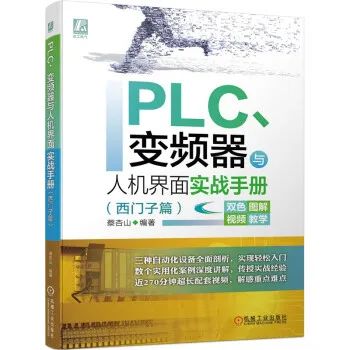
Click the image to purchase
Book Features
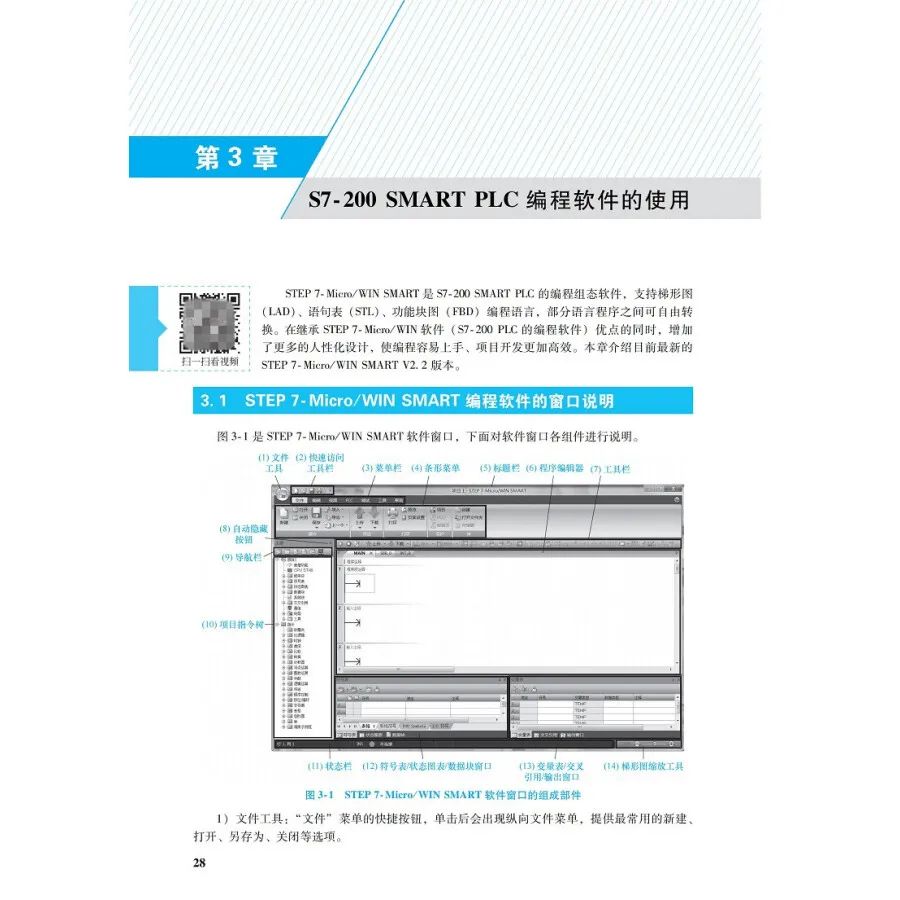
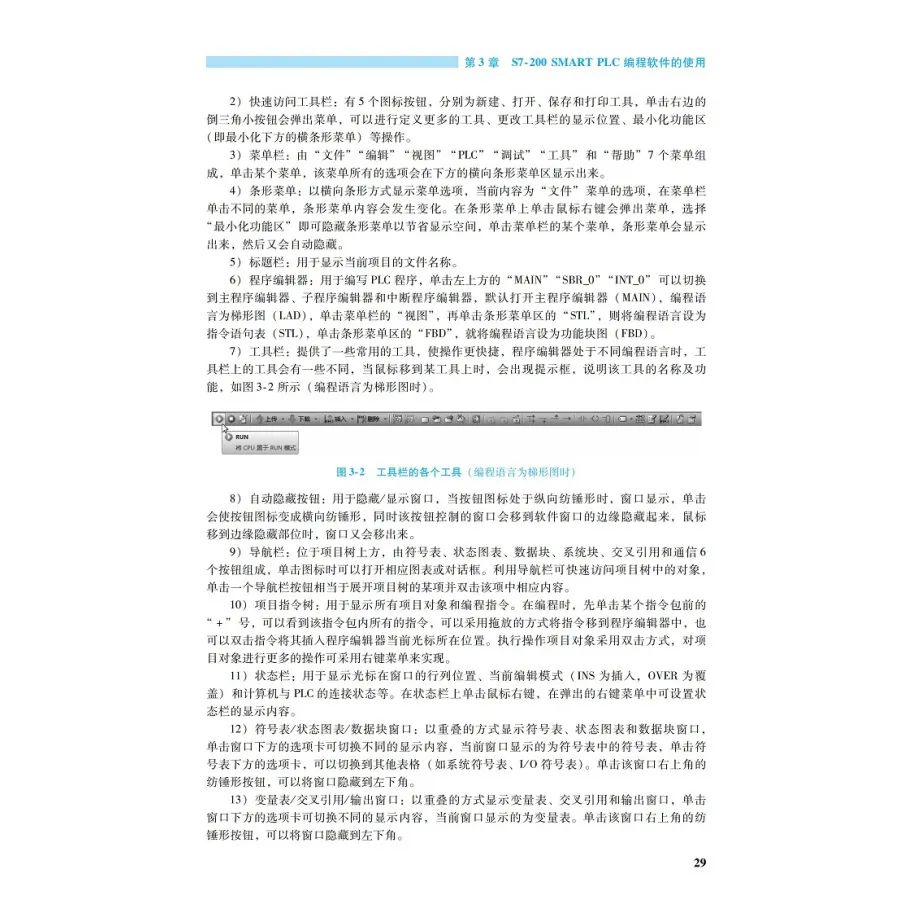
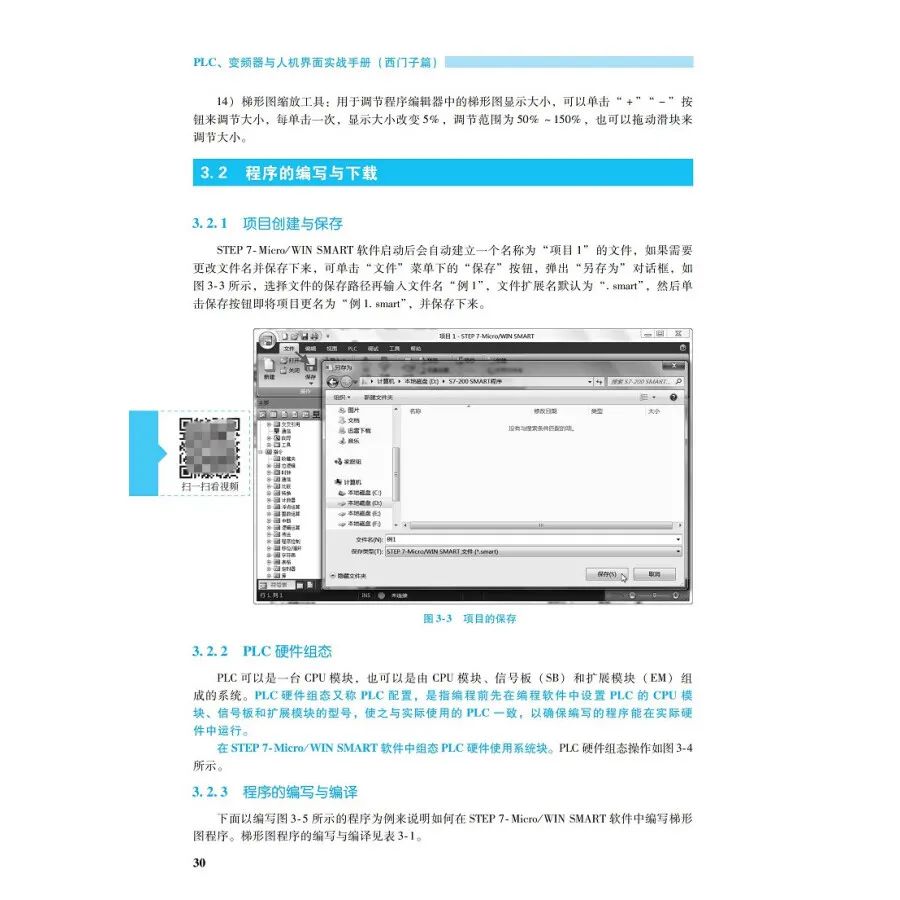
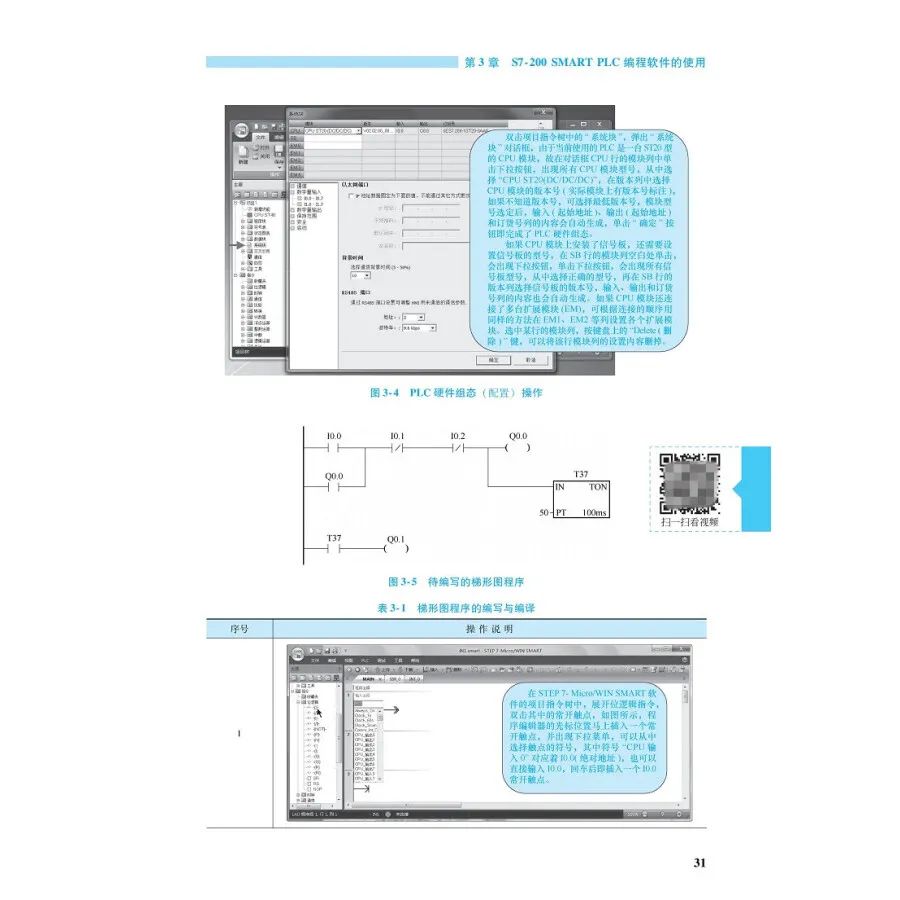
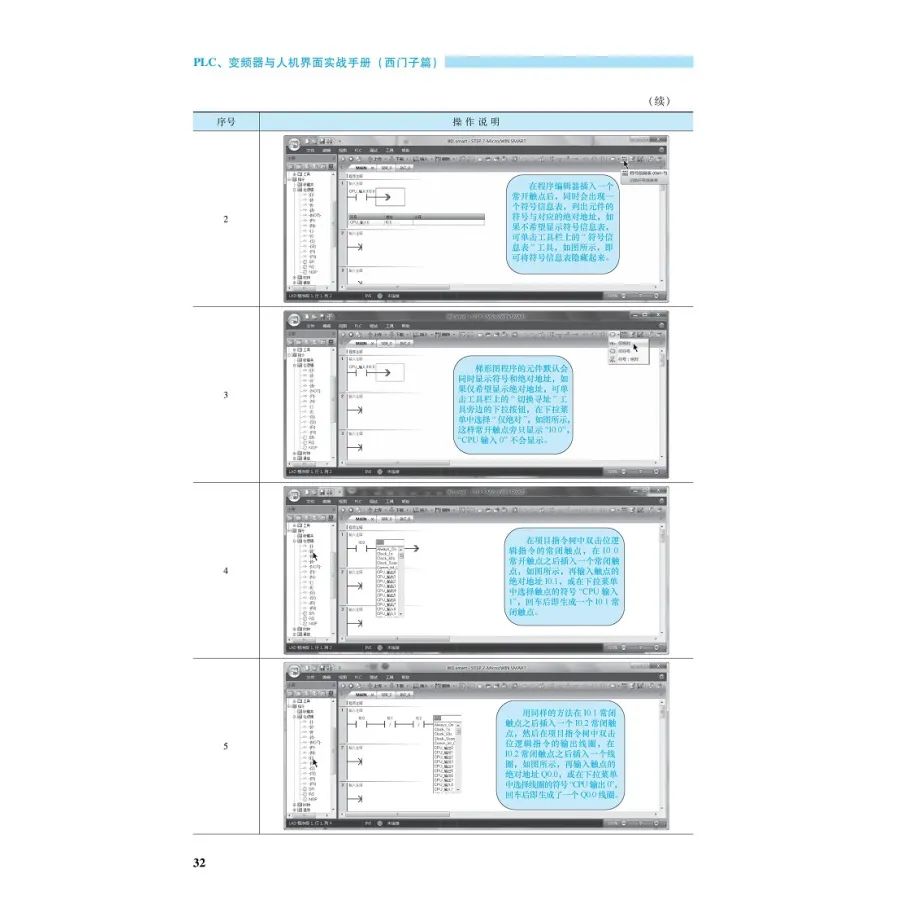
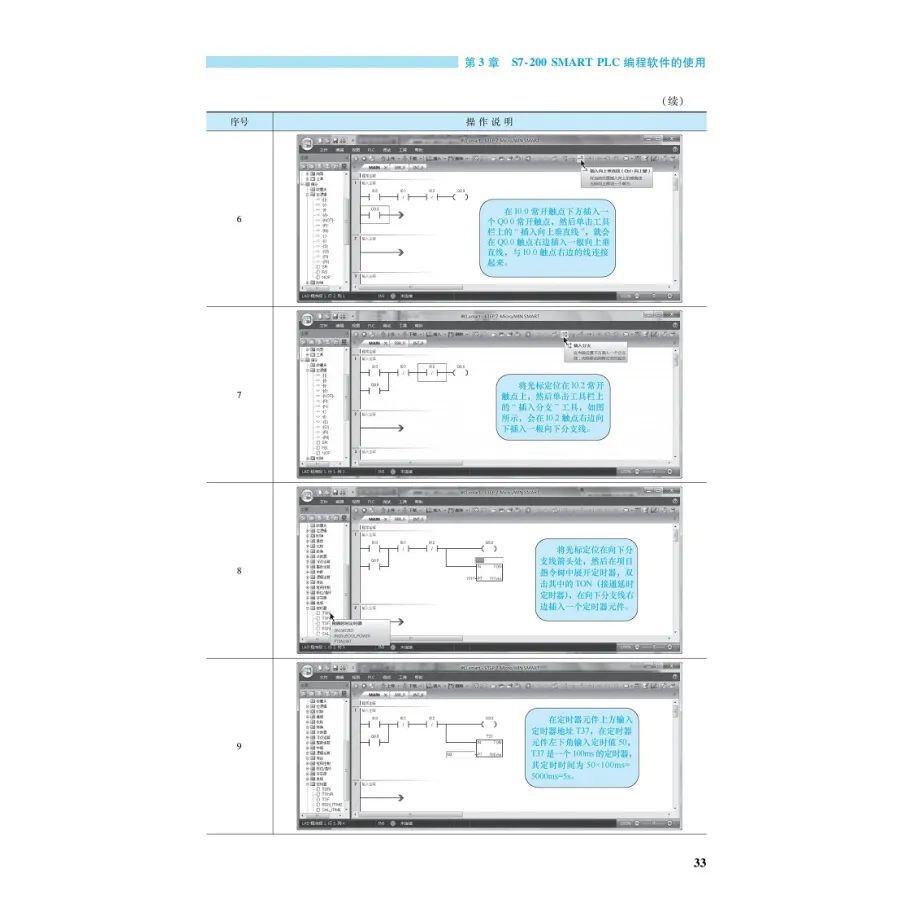
Preface
Chapter 1: PLC Basics and Practical Entry into Siemens PLCs
1.1 What is PLC
1.1.1 PLC Control vs Relay Control
1.2 Types and Characteristics of PLCs
1.2.1 Types of PLCs
1.2.2 Characteristics of PLCs
1.3 Composition and Working Principle of PLCs
1.3.1 PLC Composition Diagram
1.3.2 CPU and Memory
1.3.3 Input Interface Circuit
1.3.4 Output Interface Circuit
1.3.5 Communication Interfaces, Expansion Interfaces, and Power Supply
1.3.6 Working Modes of PLCs
1.3.7 Example of PLC Control Circuit’s Software and Hardware Working Process
1.4 PLC Programming Languages
1.4.1 Ladder Diagram
1.4.2 Function Block Diagram
1.4.3 Instruction Statement Table
1.5 Development Example of Siemens PLC Controlling Two Lights
1.5.1 General Process of PLC Application System Development
1.5.2 Control Requirements of the System
1.5.3 Selecting PLC Model and Determining Input/Output Devices and I/O Terminals
1.5.4 Drawing Circuit Diagram for Controlling Two Lights (See Figure 1-16)
1.5.5 Writing PLC Program with Programming Software
1.5.6 DC24V Power Adapter and Power Line
1.5.7 Connecting Computer and PLC with Programming Cable
1.5.8 Downloading Program to PLC
1.5.9 Simulation Debugging
1.5.10 Actual Wiring
1.5.11 Practical Operation Testing
Chapter 2: Introduction to Siemens S7-200 SMART PLC
2.1 Introduction to PLC Hardware
2.1.1 Two Types of CPU Modules
2.1.2 Description of CPU Module Panel Components
2.1.3 Wiring of CPU Module
2.1.4 Installation and Usage of Signal Board and Address Allocation
2.1.5 Common Modules and Ordering Numbers for S7-200 SMART PLC
2.2 Soft Components of PLC
2.2.1 Input and Output Relays
2.2.2 Auxiliary Relays, Special Auxiliary Relays, and Status Relays
2.2.3 Timers, Counters, and High-Speed Counters
2.2.4 Accumulators, Variable Memory, and Local Variable Memory
2.2.5 Analog Input and Output Registers
Chapter 3: Using S7-200 SMART PLC Programming Software
3.1 Description of STEP7-Micro/WIN SMART Programming Software Window
3.2 Writing and Downloading Programs
3.2.1 Creating and Saving Projects
3.2.2 PLC Hardware Configuration
3.2.3 Writing and Compiling Programs
3.2.4 Connecting PLC and Computer and Communication Settings
3.3 Editing and Commenting Programs
3.3.1 Editing Programs
3.3.2 Commenting Programs
3.4 Monitoring and Debugging Programs
3.4.1 Monitoring and Debugging Programs with Ladder Diagram
3.4.2 Monitoring and Debugging Programs with State Chart Tables and Trend Charts
3.4.3 Monitoring and Debugging Programs with State Chart Trends
3.5 Object Settings, Hardware Configuration, and Data Copying
3.5.1 Settings of Common Objects
3.5.2 Hardware Configuration
3.5.3 Backing Up, Copying Programs, and Refreshing Firmware with Storage Cards
Chapter 4: Using Basic Instructions with Examples
4.1 Bit Logic Instructions
4.1.1 Contact Instructions
4.1.2 Coil Instructions
4.1.3 Immediate Instructions
4.1.4 RS Trigger Instructions
4.1.5 No Operation Instructions
4.2 Timers
4.2.1 On Delay Timer
4.2.2 Off Delay Timer
4.2.3 Memory On Delay Timer
4.3 Counters
4.3.1 Incrementing Counter
4.3.2 Decrementing Counter
4.3.3 Increment/Decrement Counter
4.4 Common Basic Control Circuits and Ladder Diagrams
4.4.1 Start, Self-locking, and Stop Control Circuits and Ladder Diagrams
4.4.2 Forward and Reverse Interlock Control Circuits and Ladder Diagrams
4.4.3 Multi-location Control Circuits and Ladder Diagrams
4.4.4 Timer Control Circuits and Ladder Diagrams
4.4.5 Long Timer Control Circuits and Ladder Diagrams
4.4.6 Multiple Output Control Circuits and Ladder Diagrams
4.4.7 Overload Alarm Control Circuits and Ladder Diagrams
4.4.8 Flashing Control Circuits and Ladder Diagrams
4.5 Example of Siemens PLC Control of a Fountain
4.5.1 System Control Requirements
4.5.2 I/O Terminals and Input/Output Devices
4.5.3 PLC Control Circuit
4.5.4 PLC Control Program and Detailed Explanation
4.6 Example of Siemens PLC Control of Traffic Lights
4.6.1 System Control Requirements
4.6.2 I/O Terminals and Input/Output Devices
4.6.3 PLC Control Circuit
4.6.4 PLC Control Program and Detailed Explanation
4.7 Example of Siemens PLC Control of Multi-level Conveyors
4.7.1 System Control Requirements
4.7.2 I/O Terminals and Input/Output Devices
4.7.3 PLC Control Circuit
4.7.4 PLC Control Program and Detailed Explanation
4.8 Example of Siemens PLC Control of Automatic Garage Doors
4.8.1 System Control Requirements
4.8.2 I/O Terminals and Input/Output Devices
4.8.3 PLC Control Circuit
4.8.4 PLC Control Program and Detailed Explanation
Chapter 5: Using Sequence Control Instructions with Examples
5.1 Sequence Control and State Transition Diagrams
5.2 Sequence Control Instructions
5.2.1 Instruction Names and Functions
5.2.2 Examples of Instruction Usage
5.2.3 Notes on Instruction Usage
5.3 Several Methods of Sequence Control
5.3.1 Selective Branching Method
5.3.2 Parallel Branching Method
5.4 Example of Siemens PLC Control of a Liquid Mixing Device
5.4.1 System Control Requirements
5.4.2 I/O Terminals and Input/Output Devices
5.4.3 PLC Control Circuit
5.4.4 PLC Control Program and Detailed Explanation
5.5 Example of Siemens PLC Control of a Simple Robotic Arm
5.5.1 System Control Requirements
5.5.2 I/O Terminals and Input/Output Devices
5.5.3 PLC Control Circuit
5.5.4 PLC Control Program and Detailed Explanation
5.6 Example of Siemens PLC Control of Sorting Large and Small Balls
5.6.1 System Control Requirements
5.6.2 I/O Terminals and Input/Output Devices
5.6.3 PLC Control Circuit
5.6.4 PLC Control Program and Detailed Explanation
Chapter 6: Using Functional Instructions with Examples
6.1 Data Types
6.1.1 Word Length
6.1.2 Data Types and Ranges
6.1.3 Programming Format for Constants
6.2 Transfer Instructions
6.2.1 Single Data Transfer Instructions
6.2.2 Byte Immediate Transfer Instructions
6.2.3 Data Block Transfer Instructions
6.2.4 Byte Swap Instructions
6.3 Comparison Instructions
6.3.1 Byte Contact Comparison Instructions
6.3.2 Integer Contact Comparison Instructions
6.3.3 Double Word Integer Contact Comparison Instructions
6.3.4 Real Number Contact Comparison Instructions
6.3.5 Examples of Comparison Instruction Applications
6.4 Mathematical Operation Instructions
6.4.1 Addition, Subtraction, Multiplication, and Division Instructions
6.4.2 Floating Point Function Operation Instructions
6.5 Logic Operation Instructions
6.5.1 Negation Instructions
6.5.2 AND Instructions
6.5.3 OR Instructions
6.5.4 XOR Instructions
6.6 Shift and Loop Instructions
6.6.1 Left and Right Shift Instructions
6.6.2 Circular Left and Right Shift Instructions
6.7 Conversion Instructions
6.7.1 Standard Conversion Instructions
6.7.2 ASCII Code Conversion Instructions
6.8 Table Instructions
6.8.1 Fill Table Instructions
6.8.2 Look-Up Table Instructions
6.9 Clock Instructions
6.9.1 Description of Clock Instructions
6.9.2 Examples of Clock Instruction Usage
6.10 Program Control Instructions
6.10.1 Jump and Label Instructions
6.10.2 Loop Instructions
6.10.3 End, Stop, and Reset Timer Instructions
6.11 Subroutines and Subroutine Instructions
6.11.1 Subroutines
6.11.2 Subroutine Instructions
6.12 Interrupt Events and Interrupt Instructions
6.12.1 Interrupt Events and Interrupt Priorities
6.12.2 Interrupt Instructions
Chapter 7: PLC Communication
7.1 Basic Knowledge of Communication
7.1.1 Communication Methods
7.1.2 Communication Transmission Media
7.2 PLC Ethernet Communication
7.2.1 Device Types for Ethernet Connection of S7-200 SMART PLC CPU Module
7.2.2 Setting IP Addresses
7.2.3 Ethernet Communication Instructions
7.2.4 Example of PLC Ethernet Communication
7.3 PLC RS-485/RS-232 Communication
7.3.1 RS-232C, RS-422A, and RS-485 Interface Circuit Structure
7.3.2 Pin Function Definitions for RS-485/RS-232
7.3.3 Getting Port Address Instructions and Setting Port Address Instructions
7.3.4 Sending and Receiving Instructions
Chapter 8: Using Siemens Inverters
8.1 Basic Structure and Principles of Inverters
8.1.1 Two Speed Control Methods for Asynchronous Motors
8.1.2 Structure and Principles of Two Types of Inverters
8.2 Structure and Wiring of Siemens MM440 Inverter
8.2.1 Shape and Model (Ordering Number) Meanings
8.2.2 Internal Structure and External Wiring Diagram
8.2.3 Wiring of External Terminals of Main Circuit
8.2.4 Typical Actual Wiring of Control Circuit External Terminals
8.2.5 Wiring and Parameter Settings for Digital Input Terminals
8.2.6 Wiring and Parameter Settings for Analog Input Terminals
8.2.7 Wiring and Parameter Settings for Digital Output Terminals
8.2.8 Wiring and Parameter Settings for Analog Output Terminals
8.3 Stopping, Braking, and Restarting Methods for Inverters
8.3.1 Motor Nameplate Data and Corresponding Parameters for Inverters
8.3.2 Stopping Methods for Inverters
8.3.3 Braking Methods for Inverters
8.3.4 Restarting Methods for Inverters
8.4 Operating and Debugging Inverters Using Panels and External Terminals
8.4.1 Operating and Debugging Inverters Using SDP and External Terminals
8.4.2 Operating and Debugging Inverters Using BOP
8.4.3 Operating and Debugging Inverters Using AOP
8.5 Parameter Debugging and Routine Operations of MM440 Inverter
8.5.1 Resetting All Parameters of the Inverter
8.5.2 Steps and Explanations for Quick Parameter Debugging Settings
8.5.3 Routine Operations of the Inverter
Chapter 9: Inverter Application Circuits
9.1 Inverter Circuit for Controlling Forward and Reverse Rotation and Speed Adjustment via Panel Keyboard
9.1.1 Control Requirements
9.1.2 Circuit and Operation Instructions
9.1.3 Parameter Settings
9.2 Inverter Circuit for Controlling Forward and Reverse Rotation and Speed Adjustment via Panel Potentiometer
9.2.1 Control Requirements
9.2.2 Circuit and Operation Instructions
9.2.3 Parameter Settings
9.3 Multi-speed Control of Inverters and Application Circuits
9.3.1 Three Methods for Multi-speed Control of Inverters
9.3.2 Application Circuits for Multi-speed Control of Inverters
9.4 PID Control Circuit for Inverters
9.4.1 Principles of PID Control
9.4.2 PID Related Parameters
9.4.3 PID Control of Constant Pressure Water Supply Inverter Circuit and Parameter Settings
Chapter 10: Comprehensive Application of PLCs and Inverters
10.1 PLC Control of Inverter Driven Motor with Delayed Forward and Reverse Rotation Circuit
10.1.1 Control Requirements
10.1.2 Allocation of PLC Input and Output Terminals
10.1.3 Circuit Wiring
10.1.4 Inverter Parameter Settings
10.1.5 PLC Control Program and Explanation
10.2 PLC Control of Inverter for Multi-speed Operation Circuit
10.2.1 Control Requirements
10.2.2 Allocation of PLC Input and Output Terminals
10.2.3 Circuit Wiring
10.2.4 Inverter Parameter Settings
10.2.5 PLC Control Program and Explanation
10.3 Application Example of PLC Controlling Inverter via USS Protocol Communication
10.3.1 Hardware Connection for S7-200 PLC and MM440 Inverter Serial Communication
10.3.2 USS Protocol
10.3.3 Installing USS Communication Library in S7-200 PLC Programming Software
10.3.4 USS Communication Instructions
10.3.5 Application Example of S7-200 PLC Controlling MM440 Inverter via USS Protocol Communication
Chapter 11: Introduction to Siemens Touch Screens
11.1 Basic Knowledge of Touch Screens
11.1.1 Basic Components
11.1.2 Working Principles
11.2 Introduction to Siemens Exciting Series Touch Screens
11.2.1 Features of SMARTLINE Touch Screens
11.2.2 Common Models and Shapes
11.2.3 Main Component Descriptions of Touch Screens
11.2.4 Technical Specifications
11.3 Connection of Touch Screens with Other Devices
11.3.1 Power Wiring for Touch Screens
11.3.2 Ethernet Connection of Touch Screens with Configuration Computers
11.3.3 Connection of Touch Screens with Siemens PLCs
11.3.4 Connection of Touch Screens with Mitsubishi, Schneider, and Omron PLCs
Chapter 12: Quick Start with Siemens WinCC Configuration Software
12.1 Installation of WinCC flexible SMART V3 Software
12.1.1 System Requirements
12.1.2 Software Download and Installation
12.2 Configuring a Simple Project with WinCC Software
12.2.1 Creating and Saving Projects
12.2.2 Configuring Variables
12.2.3 Configuring Screens
12.2.4 Simulated Running of Projects
Chapter 13: Usage of Common Objects in WinCC Software
13.1 Examples of Using IO Domains
13.1.1 Configuring Tasks
13.1.2 Configuring Processes
13.1.3 Running Tests
13.2 Examples of Using Buttons
13.2.1 Configuring Tasks
13.2.2 Configuring Processes
13.2.3 Running Tests
13.3 Examples of Using Variable Control Object Animations
13.3.1 Configuring Tasks
13.3.2 Configuring Processes
13.3.3 Running Tests
13.3.4 Simulation Debugging
13.4 Examples of Using Pointer Variables
13.4.1 Configuring Tasks
13.4.2 Configuring Processes
13.4.3 Running Tests
13.5 Examples of Using Switches and Drawing Tools
13.5.1 Configuring Tasks
13.5.2 Configuring Processes
13.5.3 Running Tests
13.6 Examples of Using Alarm Functions
13.6.1 Basic Knowledge of Alarms
13.6.2 Configuring Tasks
13.6.3 Configuring Processes
13.6.4 Running Tests
13.7 Examples of Using Bar Charts and Trend Charts
13.7.1 Configuring Tasks
13.7.2 Configuring Processes
13.7.3 Running Tests
13.8 Examples of Using Screen Switching
13.8.1 Creating Screens (See Table 13-10)
13.8.2 Setting Screen Switching Using Drag-and-Drop Button Generation
13.8.3 Implementing Specified Screen Switching Using Buttons with Screen Switching Functions (See Table 13-11)
13.8.4 Implementing Any Number Screen Switching Using Buttons with Screen Switching Functions
Chapter 14: Practical Control of PLCs by Siemens Touch Screens
14.1 Clarifying Requirements, Planning Variables and Circuits
14.1.1 Control Requirements
14.1.2 Selecting PLC and Touch Screen Models and Allocating Variables
14.1.3 Device Connections and Circuits
14.2 Writing and Downloading PLC Programs
14.2.1 Writing PLC Programs
14.2.2 Connecting PLC with Computer and Settings
14.2.3 Downloading and Uploading PLC Programs
14.3 Configuring and Downloading Touch Screen Project Items
14.3.1 Creating Touch Screen Project File
14.3.2 Configuring Touch Screen Connection with PLC
14.3.3 Configuring Variables
14.3.4 Configuring Indicator Lights
14.3.5 Configuring Buttons
14.3.6 Configuring Status Value Monitors
14.3.7 Configuring Instruction Texts
14.3.8 Downloading Projects to Touch Screens
14.3.9 Common Reasons and Solutions for Inability to Download Projects
14.3.10 Updating Touch Screen Versions Using ProSave Software
14.4 Operating and Monitoring Tests for Siemens Touch Screens Connected to PLCs
14.4.1 Hardware Connection and Communication Settings of Touch Screens Connected to PLCs via Network Cable
14.4.2 Hardware Connection and Communication Settings of Touch Screens Connected to PLCs via Serial Cable
14.4.3 Practical Operation Testing of Siemens Touch Screens Connected to PLCs
Source: Jinfen Mall

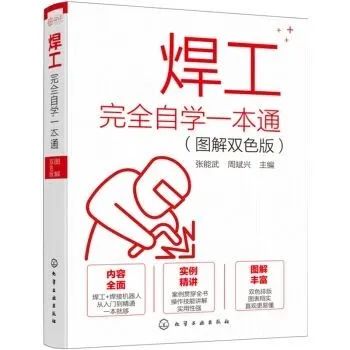
Welding + Welding Robot Operation Skills Fully Covered
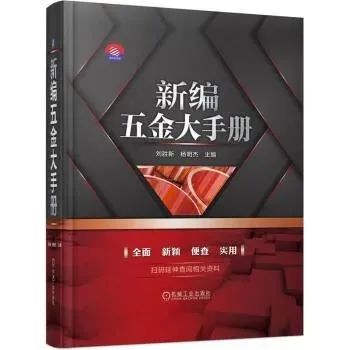
Essential for Hardware Data Reference
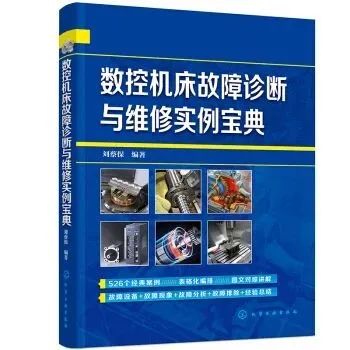
Explaining CNC Machine Tool Fault Diagnosis and Repair with Examples